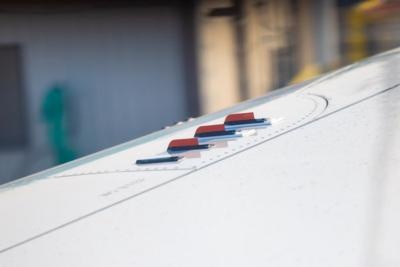Sat, Jul 29, 2023
Heat-Sensitive Metallurgy Allows for Retractable, Simple Vortex Generators
Normally vortex generators have always been welded onto whatever aerodynamic surface requires their surface. Yet, these little aero-rakes are normally only required for very specific modes of a given flight, such as low speed.

During the rest of the flight regime, the devices simply generate drag. Of course, that drag impacts fuel efficiency. If, however, the vortex generators could be retracted to any degree, that drag could largely be reduced. NASA is showing off a unique and passive system for self-retracting vortex generators at Airventure 2023. The basics of this device are demonstrated in a small model of a wing section in the NASA pavilion. This very simple device stands as a vortex generator when at low altitude. But, as the aircraft climbs to higher altitudes it folds shut. It does so automatically and without external power. What makes these retractable vortex generators function is a shape memory alloy developed by NASA. These alloys have been developed in a NASA laboratory through mixing specific types of metals together using special machinery. Once created, the researchers can “train” the alloy by forming it into a desired shape at a given temperature. Each time the alloy returns to that
temperature, it will return to that shape. When a strand of that alloy is used to move the fin of a vortex generator it gains a new, and very NASA name: the “Shape Memory Alloy Reconfigurable Technology Vortex Generator,” SMARTVG.
What makes the system work is the fact that near-the-ground temperatures are often far higher than they are at cruising flight altitudes. So, the alloy is twisted and trained to support the vortex generator fin in the up position at those temperatures. Then it is trained to twist and fold the fin down in the extreme cold of the upper atmosphere.
In that basic configuration, the system is completely passive. However, in extreme winter flying the system can be fooled into remaining retracted. Thus, a pilot-controlled warming system will need to be developed to augment the once-passive system.
This system was tested in a small form in 2019 and in October 2022. NASA partnered with Boeing aboard their 777-200 ecoDemonstrator and flew a sample SMARTVG. The early 2019 flights showed that the passive system worked as advertised. The 2022 flights tested the heating system with good cold weather results. Nasa stated that there is still more flight testing data ahead before they can declare the system to be operational, but the initial tests looked good.
More News
Terminal Radar Service Area Airspace surrounding designated airports wherein ATC provides radar vectoring, sequencing, and separation on a full-time basis for all IFR and participa>[...]
Very High Frequency (VHF) The frequency band between 30 and 300 MHz. Portions of this band, 108 to 118 MHz, are used for certain NAVAIDs; 118 to 136 MHz are used for civil air/grou>[...]
“From approximately November 2021 through January 2022, Britton-Harr, acting on behalf of AeroVanti, entered into lease-purchase agreements for five Piaggio-manufactured airc>[...]
Also: Virtual FLRAA Prototype, IFR-Capable Autonomous A/C, NS-32 Crew, Golden Dome Missile Defense Bombardier announced that the first production Global 8000 successfully completed>[...]
Aero Linx: The 1-26 Association (Schweizer) The Association’s goal is to foster the helpfulness, the camaraderie, and the opportunity for head-to-head competition that is fou>[...]
 ANN's Daily Aero-Term (05.29.25): Terminal Radar Service Area
ANN's Daily Aero-Term (05.29.25): Terminal Radar Service Area ANN's Daily Aero-Term (05.30.25): Very High Frequency (VHF)
ANN's Daily Aero-Term (05.30.25): Very High Frequency (VHF) Aero-News: Quote of the Day (05.30.25)
Aero-News: Quote of the Day (05.30.25) Airborne 05.23.25: Global 8000, Qatar B747 Accepted, Aviation Merit Badge
Airborne 05.23.25: Global 8000, Qatar B747 Accepted, Aviation Merit Badge ANN's Daily Aero-Linx (05.30.25)
ANN's Daily Aero-Linx (05.30.25)



